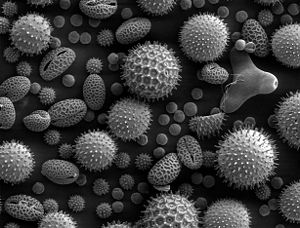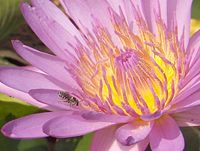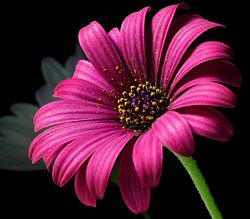Difference between revisions of "Pollen" - New World Encyclopedia
Miriam Jones (talk | contribs) |
Miriam Jones (talk | contribs) |
||
| Line 4: | Line 4: | ||
'''Pollen''', or ''flower sperm'', is a fine to coarse powder consisting of '''''microgametophytes''''' ('''pollen grains'''), which carry the male gametes of [[gymnosperm|seed plants]]. Each pollen grain contains one or two generative cells (the male gametes) and a vegetative cell. The group of three cells is surrounded by a cellulose cell wall and a thick, tough outer wall made of sporopollenin. | '''Pollen''', or ''flower sperm'', is a fine to coarse powder consisting of '''''microgametophytes''''' ('''pollen grains'''), which carry the male gametes of [[gymnosperm|seed plants]]. Each pollen grain contains one or two generative cells (the male gametes) and a vegetative cell. The group of three cells is surrounded by a cellulose cell wall and a thick, tough outer wall made of sporopollenin. | ||
| − | Pollen is produced in the '''microsporangium''' (contained in the | + | Pollen is produced in the '''microsporangium''' (contained in the anther of an [[Flowering plant|angiosperm]] [[flower]] or male cone of a coniferous plant). Pollen grains come in a wide variety of shapes, sizes, and surface markings characteristic of the species (see photomicrograph at right). Most, but certainly not all, are spherical. Pollen grains of pines, firs, and spruces are winged. The smallest pollen grain, that of the Forget-me-not plant (''Myosotis'' sp.), is around 6 µm (0.006 mm) in diameter. The study of pollen is called palynology and is highly useful in paleontology, [[paleoclimatology]], [[paleobotany]], archeology, and forensics. |
| − | Except in the case of some submerged aquatic plants the mature pollen-grain has a double wall, a thin delicate wall of unaltered cellulose (the endospore or intine) and a tough outer cuticularized exospore or exine. The exine often bears spines or warts, or is variously sculptured, and the character of the markings is often of value for identifying genus, species, or even cultivar or individual. Germination of the microspore begins before it leaves the pollen-sac. In very few cases has anything representing prothallial development been observed; generally a small cell (the antheridial or generative cell) is cut off, leaving a larger tube-cell. | + | Except in the case of some submerged aquatic plants the mature pollen-grain has a double wall, a thin delicate wall of unaltered cellulose (the endospore or intine) and a tough outer cuticularized exospore or exine. The exine often bears spines or warts, or is variously sculptured, and the character of the markings is often of value for identifying genus, species, or even cultivar or individual. Germination of the microspore begins before it leaves the pollen-sac. In very few cases has anything representing prothallial development been observed; generally a small cell (the antheridial or generative [[cell]]) is cut off, leaving a larger tube-cell. |
| − | The transfer of pollen grains to the female reproductive structure ('''''pistil''''' in angiosperms) is called '''pollination'''. This transfer can be mediated by the wind, in which case the plant is described as '''anemophilous''' (literally wind-loving). Anemophilous plants typically produce great quantities of very lightweight pollen grains, often with air-sacs, and generally have inconspicuous flowers. '''Entomophilous''' (literally insect-loving) | + | The transfer of pollen grains to the female reproductive structure ('''''pistil''''' in angiosperms) is called '''pollination'''. This transfer can be mediated by the wind, in which case the plant is described as '''anemophilous''' (literally wind-loving). Anemophilous plants typically produce great quantities of very lightweight pollen grains, often with air-sacs, and generally have inconspicuous flowers. '''Entomophilous''' (literally insect-loving) [[plant]]s produce pollen that is relatively heavy, sticky and protein-rich, for dispersal by [[insect]] pollinators attracted to their [[flower]]s. |
| − | When placed on the | + | When placed on the stigma, under favorable circumstances, the pollen-grain puts forth a pollen-tube which grows down the tissue of the style to the ovary, and makes its way along the placenta, guided by projections or hairs, to the mouth of an ovule. The nucleus of the tube-cell has meanwhile passed into the tube, as does also the generative nucleus which divides to form two male- or sperm-cells. The male-cells are carried to their destination in the tip of the pollen-tube. |
==Humans and Pollen== | ==Humans and Pollen== | ||
| Line 16: | Line 16: | ||
Allergy to pollen is called hay fever. Generally pollens that cause allergies are those of anemophilous, because the lightweight pollen grains are produced in great quantities for wind dispersal. Breathing air containing these pollen grains brings them into contact with the nasal passages. | Allergy to pollen is called hay fever. Generally pollens that cause allergies are those of anemophilous, because the lightweight pollen grains are produced in great quantities for wind dispersal. Breathing air containing these pollen grains brings them into contact with the nasal passages. | ||
| − | In the US, people often falsely blame entomophilous flowering plants, such as the conspicuous goldenrod flower, for allergies. Since this pollen does not become airborne, however, these plants are not repsonsible for | + | In the US, people often falsely blame entomophilous flowering plants, such as the conspicuous goldenrod flower, for allergies. Since this pollen does not become airborne, however, these plants are not repsonsible for allergies. The late summer and fall pollen allergies are usually caused by ragweed (''Ambrosia aratemisiifolia'' and ''Ambrosia trifida''), a widespread anemophilous [[plant]]. Arizona was once regarded as a haven for people with pollen allergies, since ragweed does not grow in the desert. However, as suburbs grew and people began establishing irrigated lawns and gardens, ragweed gained a foothold and Arizona lost its claim of freedom from hay fever. |
Anemophilous spring blooming plants such as oak (''Quercus''), birch (''Betula''), hickory (''Carya''), pecan (''Carya illinoinsis''), and early summer grasses may also induce pollen allergies. Cultivated flowers are most often entomophilous and do not cause allergies. | Anemophilous spring blooming plants such as oak (''Quercus''), birch (''Betula''), hickory (''Carya''), pecan (''Carya illinoinsis''), and early summer grasses may also induce pollen allergies. Cultivated flowers are most often entomophilous and do not cause allergies. | ||
| Line 22: | Line 22: | ||
==Pollen as a Food Source== | ==Pollen as a Food Source== | ||
| − | [[Image:Flower-04-KayEss-2.jpeg|200px|thumb|right|A bee pollinating a | + | [[Image:Flower-04-KayEss-2.jpeg|200px|thumb|right|A bee pollinating a Water lily flower]] |
| − | Pollen is sold as a nutritional supplement, marketed as "bee pollen" (even though it is of course from flowers). There is doubt amongst conventional practitioners that taking pollen has any biological effect, although may possibly cause | + | Pollen is sold as a nutritional supplement, marketed as "bee pollen" (even though it is of course from flowers). There is doubt amongst conventional practitioners that taking pollen has any biological effect, although may possibly cause allergic reactions in sensitive people. |
| − | Many [[tree]]s and flowering | + | Many [[tree]]s and [[flowering plant]]s are a good source of pollen for honeybees. Bees will collect pollen from some grasses and grains when they cannot find pollens with more nutritional value, however, anemophilous [[plant]]s such as grasses generally have very low real value to bees. Some windblown pollen is likely to be inadvertently collected by [[bee]]s, since they bear a static charge. Ragweed and pine pollen can settle on [[leaf|leaves]] and other flowers, to add to the total quantity of pollens that are found upon analysis of gathered pollen. |
==Pollen Research== | ==Pollen Research== | ||
| − | '''Palynology''' is the study of pollen and spores, both living and in fossil form. It is commonly used by [[geology|geologists]] and [[paleoclimatology|paleoclimatologists]] as a means to study past environments, | + | '''Palynology''' is the study of pollen and spores, both living and in [[fossil]] form. It is commonly used by [[geology|geologists]] and [[paleoclimatology|paleoclimatologists]] as a means to study past environments, by identifying pollen and spore [[species]] at a certain stratigraphic interval, representing a given time in [[earth]]'s history. It is also a useful tool for archeologists for gaining insight on the way past civilizations lived and the crops they produced, based on the pollen found in artifacts from that time. |
Revision as of 02:07, 23 July 2006
Pollen, or flower sperm, is a fine to coarse powder consisting of microgametophytes (pollen grains), which carry the male gametes of seed plants. Each pollen grain contains one or two generative cells (the male gametes) and a vegetative cell. The group of three cells is surrounded by a cellulose cell wall and a thick, tough outer wall made of sporopollenin.
Pollen is produced in the microsporangium (contained in the anther of an angiosperm flower or male cone of a coniferous plant). Pollen grains come in a wide variety of shapes, sizes, and surface markings characteristic of the species (see photomicrograph at right). Most, but certainly not all, are spherical. Pollen grains of pines, firs, and spruces are winged. The smallest pollen grain, that of the Forget-me-not plant (Myosotis sp.), is around 6 µm (0.006 mm) in diameter. The study of pollen is called palynology and is highly useful in paleontology, paleoclimatology, paleobotany, archeology, and forensics.
Except in the case of some submerged aquatic plants the mature pollen-grain has a double wall, a thin delicate wall of unaltered cellulose (the endospore or intine) and a tough outer cuticularized exospore or exine. The exine often bears spines or warts, or is variously sculptured, and the character of the markings is often of value for identifying genus, species, or even cultivar or individual. Germination of the microspore begins before it leaves the pollen-sac. In very few cases has anything representing prothallial development been observed; generally a small cell (the antheridial or generative cell) is cut off, leaving a larger tube-cell.
The transfer of pollen grains to the female reproductive structure (pistil in angiosperms) is called pollination. This transfer can be mediated by the wind, in which case the plant is described as anemophilous (literally wind-loving). Anemophilous plants typically produce great quantities of very lightweight pollen grains, often with air-sacs, and generally have inconspicuous flowers. Entomophilous (literally insect-loving) plants produce pollen that is relatively heavy, sticky and protein-rich, for dispersal by insect pollinators attracted to their flowers.
When placed on the stigma, under favorable circumstances, the pollen-grain puts forth a pollen-tube which grows down the tissue of the style to the ovary, and makes its way along the placenta, guided by projections or hairs, to the mouth of an ovule. The nucleus of the tube-cell has meanwhile passed into the tube, as does also the generative nucleus which divides to form two male- or sperm-cells. The male-cells are carried to their destination in the tip of the pollen-tube.
Humans and Pollen
Allergy to pollen is called hay fever. Generally pollens that cause allergies are those of anemophilous, because the lightweight pollen grains are produced in great quantities for wind dispersal. Breathing air containing these pollen grains brings them into contact with the nasal passages.
In the US, people often falsely blame entomophilous flowering plants, such as the conspicuous goldenrod flower, for allergies. Since this pollen does not become airborne, however, these plants are not repsonsible for allergies. The late summer and fall pollen allergies are usually caused by ragweed (Ambrosia aratemisiifolia and Ambrosia trifida), a widespread anemophilous plant. Arizona was once regarded as a haven for people with pollen allergies, since ragweed does not grow in the desert. However, as suburbs grew and people began establishing irrigated lawns and gardens, ragweed gained a foothold and Arizona lost its claim of freedom from hay fever.
Anemophilous spring blooming plants such as oak (Quercus), birch (Betula), hickory (Carya), pecan (Carya illinoinsis), and early summer grasses may also induce pollen allergies. Cultivated flowers are most often entomophilous and do not cause allergies.
Pollen as a Food Source
Pollen is sold as a nutritional supplement, marketed as "bee pollen" (even though it is of course from flowers). There is doubt amongst conventional practitioners that taking pollen has any biological effect, although may possibly cause allergic reactions in sensitive people.
Many trees and flowering plants are a good source of pollen for honeybees. Bees will collect pollen from some grasses and grains when they cannot find pollens with more nutritional value, however, anemophilous plants such as grasses generally have very low real value to bees. Some windblown pollen is likely to be inadvertently collected by bees, since they bear a static charge. Ragweed and pine pollen can settle on leaves and other flowers, to add to the total quantity of pollens that are found upon analysis of gathered pollen.
Pollen Research
Palynology is the study of pollen and spores, both living and in fossil form. It is commonly used by geologists and paleoclimatologists as a means to study past environments, by identifying pollen and spore species at a certain stratigraphic interval, representing a given time in earth's history. It is also a useful tool for archeologists for gaining insight on the way past civilizations lived and the crops they produced, based on the pollen found in artifacts from that time.
External links
- Pollen and Spore Identification Literature
- Paleobotany and Palynology at the Florida Museum of Natural History
- Palynology at the University of Arizona
- Palynology at the University of Sheffield
This article incorporates text from the Encyclopædia Britannica Eleventh Edition, a publication now in the public domain.
- Palynology in Utrecht, the Netherlands
- Bee Pollen, Royal Jelly, and Propolis - A sceptical view of the benefits of taking bee pollen.
- Pollen - Menace or Miracle?, discussion on its purpose in biology and as an allergen
Credits
New World Encyclopedia writers and editors rewrote and completed the Wikipedia article in accordance with New World Encyclopedia standards. This article abides by terms of the Creative Commons CC-by-sa 3.0 License (CC-by-sa), which may be used and disseminated with proper attribution. Credit is due under the terms of this license that can reference both the New World Encyclopedia contributors and the selfless volunteer contributors of the Wikimedia Foundation. To cite this article click here for a list of acceptable citing formats.The history of earlier contributions by wikipedians is accessible to researchers here:
The history of this article since it was imported to New World Encyclopedia:
Note: Some restrictions may apply to use of individual images which are separately licensed.


